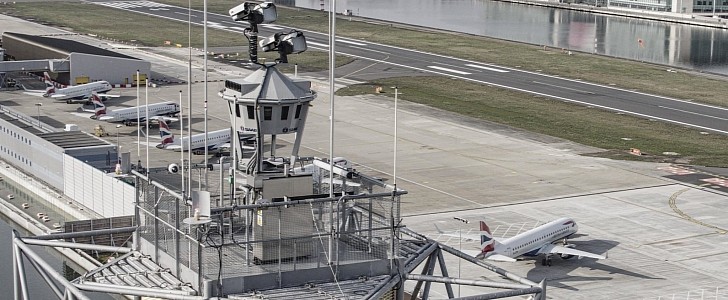With everything being “smart” these days, it was only natural for “smart infrastructure” to develop as well. A great example of this is Saab’s Digital Tower that is now operating at London City Airport.
London City Airport has now become the first major airport in the world that is controlled entirely by a remote digital air traffic control tower. This is thanks to the innovative technology developed by Saab.
So, how exactly does a remote air traffic control tower work? First, the cameras and sensors at the airport get a complete view of the airfield, which they then transmit to a control room all the way up in Hampshire. Next, a team of controllers actually instruct aircraft movements, based on the images, the audio data and the radar readings from the digital control tower at the airport.
There are 16 high-definition cameras and sensors mounted on the tall pole at London City Airport. Through a high-speed fiber connection, the live footage and other data captured at the airport are sent to NATS’ (National Air Traffic Services) control tower that is 85 miles (136 km) away, in Swanwick, Hampshire.
According to Saab, the Digital Tower’s technology is able to identify flight data, zoom in and out or provide more graphics in order to enhance visibility. All of this information can be used by controllers who are in a different location.
The main advantage of replacing standard air traffic control towers with a digital remote one is that controllers have a better situational awareness and can, therefore, act faster. The live footage, audio and radar data give them a full picture of what is going on, which improves overall efficiency and safety. Another benefit is an increased air traffic capacity, since the remote control tower is able to cover a larger area of operations.
Saab’s Digital Tower has also been implemented at other European airports, as well as being selected for the Royal Navy’s UK air stations.
So, how exactly does a remote air traffic control tower work? First, the cameras and sensors at the airport get a complete view of the airfield, which they then transmit to a control room all the way up in Hampshire. Next, a team of controllers actually instruct aircraft movements, based on the images, the audio data and the radar readings from the digital control tower at the airport.
There are 16 high-definition cameras and sensors mounted on the tall pole at London City Airport. Through a high-speed fiber connection, the live footage and other data captured at the airport are sent to NATS’ (National Air Traffic Services) control tower that is 85 miles (136 km) away, in Swanwick, Hampshire.
According to Saab, the Digital Tower’s technology is able to identify flight data, zoom in and out or provide more graphics in order to enhance visibility. All of this information can be used by controllers who are in a different location.
The main advantage of replacing standard air traffic control towers with a digital remote one is that controllers have a better situational awareness and can, therefore, act faster. The live footage, audio and radar data give them a full picture of what is going on, which improves overall efficiency and safety. Another benefit is an increased air traffic capacity, since the remote control tower is able to cover a larger area of operations.
Saab’s Digital Tower has also been implemented at other European airports, as well as being selected for the Royal Navy’s UK air stations.

